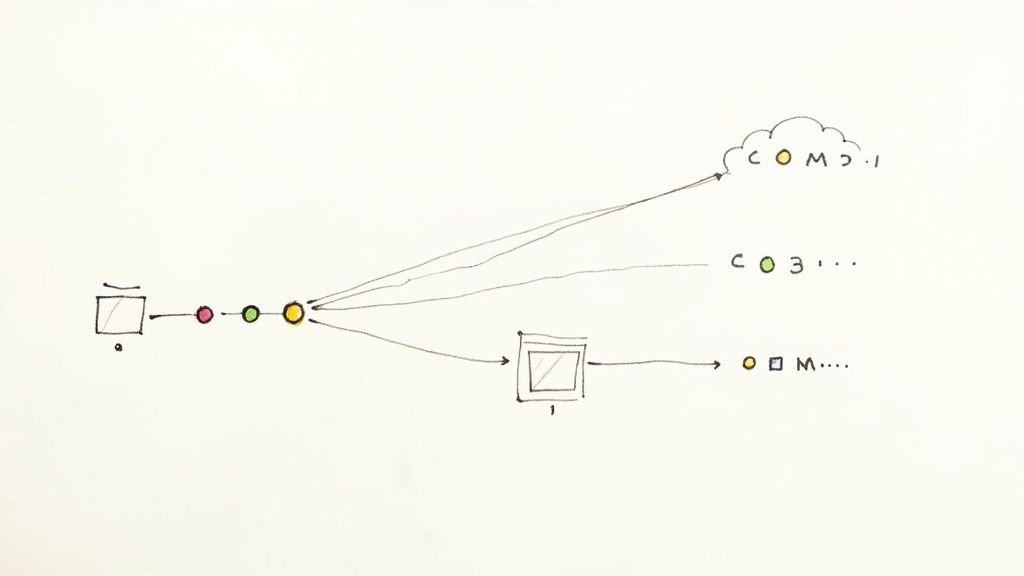Best practice for software development: A proven guide
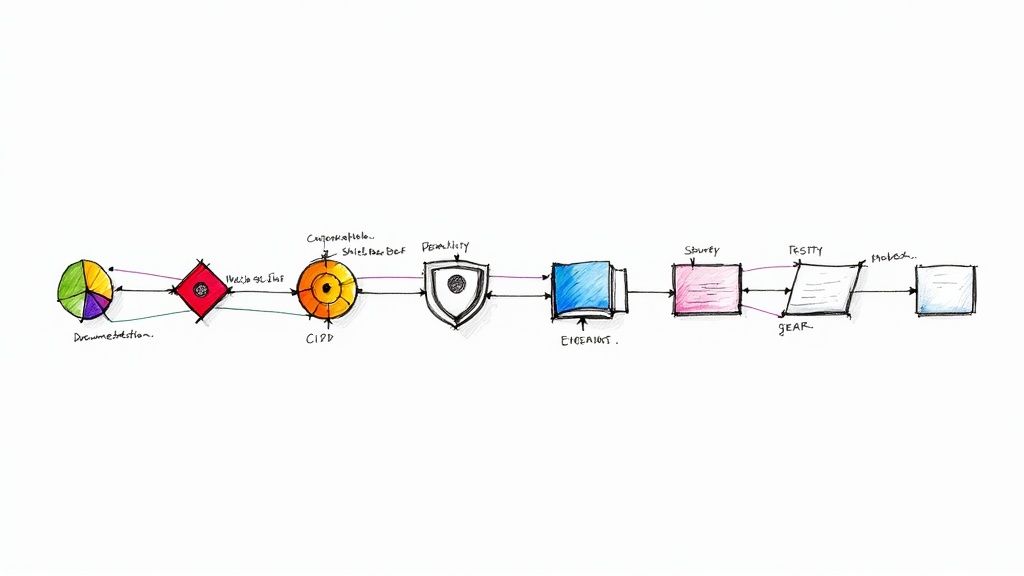
In the competitive world of software engineering, the difference between a successful project and a failed one often comes down to the team's discipline and methodology. Simply writing code that works is no longer enough. The real challenge lies in building software that is scalable, maintainable, and resilient over time. This requires a deliberate and structured approach, grounded in proven principles. Adhering to a robust set of best practices is not about rigid rules; it's about creating a sustainable framework for excellence that minimizes technical debt and maximizes efficiency.
This guide moves beyond generic advice to provide a comprehensive blueprint for modern engineering. We will dissect ten essential strategies that high-performing teams use to deliver superior products consistently. You'll find actionable insights on everything from foundational coding principles like SOLID to workflow optimizations like Continuous Integration and Continuous Deployment (CI/CD). We'll also cover crucial team dynamics, including effective code reviews and the power of iterative Agile development. While these established practices form the bedrock of quality engineering, it's also important to be aware of emerging paradigms. To understand a cutting-edge approach that transforms app development, delve deeper into what is vibe coding and how this AI-powered method works.
Whether you are an enterprise IT leader aiming to standardize quality, a DevOps engineer streamlining pipelines, or a developer committed to craftsmanship, mastering these concepts is non-negotiable. By implementing these practices, your team can accelerate release cycles, reduce bugs, and build a collaborative culture focused on quality. Let's explore the specific techniques that will elevate your development process from functional to exceptional.
1. Test-Driven Development (TDD)
Test-Driven Development (TDD) flips the traditional development sequence on its head. Instead of writing production code first and tests later (if at all), TDD mandates writing an automated test before a single line of functional code is written. This approach is a core discipline in modern software engineering and a fundamental best practice for software development that ensures quality is built-in, not bolted on.
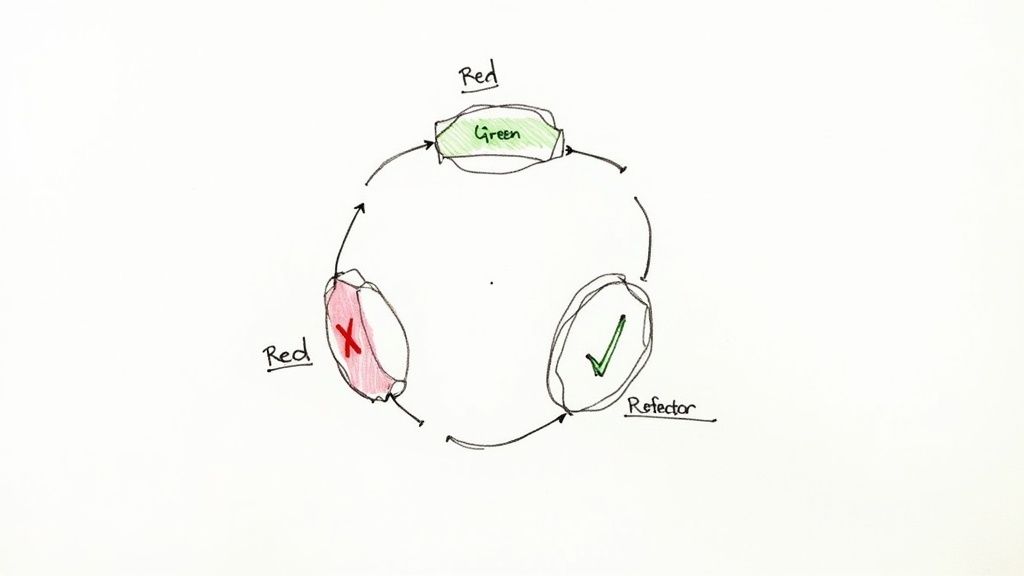
The TDD process follows a simple, yet powerful, cycle known as Red-Green-Refactor:
- Red: Write a failing test for a new feature or improvement. The test fails because the required code does not yet exist.
- Green: Write the absolute minimum amount of code necessary to make the test pass. The goal here is not elegance, but correctness.
- Refactor: With a passing test as a safety net, clean up the code. Improve its structure, readability, and performance without changing its external behavior.
This cycle, popularized by Kent Beck and the Extreme Programming (XP) community, creates a tight feedback loop. It forces developers to think clearly about requirements before implementation, leading to more robust and maintainable designs.
Why It's a Best Practice
Adopting TDD offers significant advantages. It naturally produces a comprehensive suite of regression tests, drastically reducing the fear associated with code changes and making refactoring safer. This high test coverage builds confidence and reduces the number of bugs that make it to production. Companies like Google and Microsoft have integrated TDD into their workflows to improve code quality and developer productivity across large-scale projects.
How to Implement TDD
To get started with TDD, focus on small, isolated behaviors. Use popular testing frameworks that align with your technology stack, such as Jest for JavaScript, JUnit for Java, or PyTest for Python.
- Start Small: Begin by applying TDD to a new, simple function. Focus on mastering the Red-Green-Refactor rhythm.
- Be Descriptive: Name your tests clearly to describe the intended behavior (e.g.,
test_should_return_zero_for_empty_input). - Run Tests Often: Integrate test execution into your workflow, running them frequently to catch issues immediately.
By making tests a first-class citizen in the development process, you ensure your application is both correct and easy to evolve. For teams looking to improve their testing skills, exploring a comprehensive guide on unit testing best practices can provide deeper insights into writing effective and maintainable tests.
2. Code Review and Peer Review
Code Review is a systematic examination of source code intended to find and fix mistakes overlooked in the initial development phase, improving both the quality of the software and the skills of developers. This collaborative process, where peers analyze code for correctness, security vulnerabilities, and adherence to standards, is a cornerstone best practice for software development that fosters a culture of collective ownership.
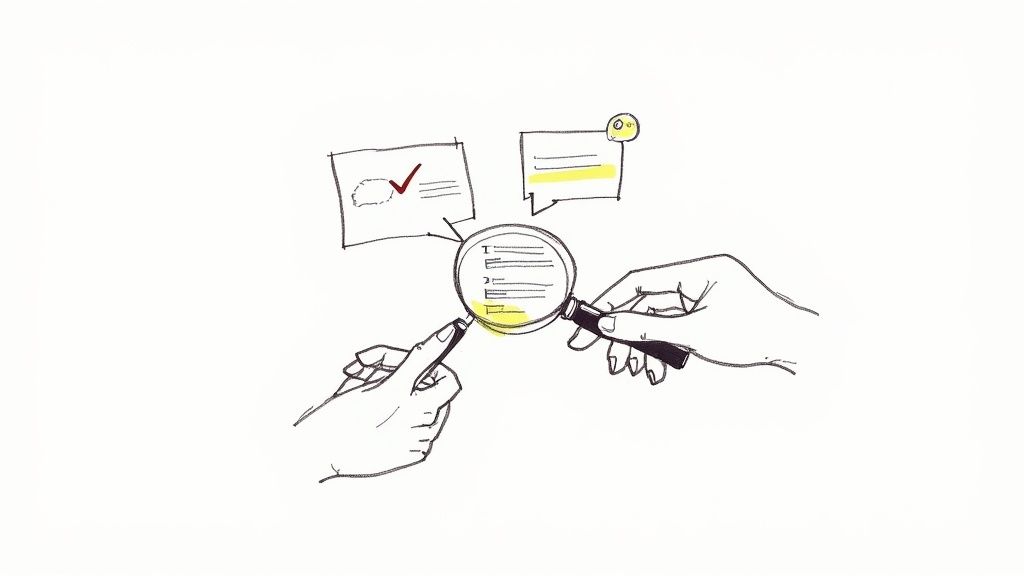
The process typically involves a developer submitting their code for review, often through a pull request (PR) on a platform like GitHub or GitLab. Other team members then asynchronously review the changes, providing feedback, asking questions, and suggesting improvements. This dialogue continues until the code meets the team's quality standards and is approved for integration.
This practice was heavily popularized by the open-source community, particularly the Linux kernel developers, and has been formalized by tech giants. It creates a critical quality gate, ensuring that no single individual becomes a bottleneck or a single point of failure.
Why It's a Best Practice
Adopting a rigorous code review process significantly reduces bugs and enhances system stability. It serves as an invaluable knowledge-sharing mechanism, helping to onboard new developers and distribute domain expertise across the team. Companies like Google, with its Critique tool, and Facebook have demonstrated that institutionalizing code reviews leads to higher-quality, more secure, and more maintainable codebases at scale.
How to Implement Code Review
Effective code reviews require clear guidelines and a constructive, respectful culture. The goal is to improve the code, not to criticize the author.
- Keep It Small: Submit small, focused pull requests (ideally under 400 lines of code) that address a single concern.
- Automate First: Use linters and static analysis tools to automatically check for style and common errors before a human reviewer even sees the code.
- Be Constructive: Frame feedback around the code's behavior and structure. Offer suggestions rather than commands (e.g., "What do you think about handling this edge case?" instead of "Fix this.").
- Establish Guidelines: Create a checklist or clear standards for what reviewers should look for, ensuring consistency.
By making peer review an integral part of your workflow, you build a resilient team and a higher-quality product. To get the most out of this process, mastering pull request best practices is essential for streamlining reviews and maximizing their effectiveness.
3. Continuous Integration / Continuous Deployment (CI/CD)
Continuous Integration and Continuous Deployment (CI/CD) represent a cornerstone practice in modern software development, automating the path from code commit to production release. CI is the practice of frequently merging developers' code changes into a central repository, after which automated builds and tests are run. CD extends this by automatically deploying all code changes that pass the CI stage to a testing or production environment. This automated pipeline is a crucial best practice for software development that enables speed and reliability.
The CI/CD pipeline automates the key stages of software delivery:
- Commit: Developers push code changes to a shared repository.
- Build: An automated system compiles the code and runs initial checks.
- Test: A comprehensive suite of automated tests (unit, integration, end-to-end) validates the build.
- Deploy: If all tests pass, the change is automatically deployed to production.
This process, championed by figures like Jez Humble and David Farley, creates a rapid, reliable feedback loop. It minimizes manual intervention, reduces the risk associated with large, infrequent releases, and allows teams to deliver value to users faster and more consistently.
Why It's a Best Practice
Adopting a CI/CD pipeline drastically accelerates release cycles and improves developer productivity. By automating builds and tests, teams catch bugs earlier, reduce integration conflicts, and lower the risk of manual deployment errors. This high degree of automation builds confidence in the release process. Companies like Netflix and Amazon leverage sophisticated CI/CD pipelines to deploy changes thousands of times per day, demonstrating its power to enable agility and innovation at scale.
How to Implement CI/CD
To start with CI/CD, focus on automating the build and test phases before moving to full deployment. Use established tools like GitLab CI, GitHub Actions, Jenkins, or CircleCI to orchestrate your pipeline.
- Start with CI: Begin by automating the build and unit test process for every code commit. Ensure the pipeline is fast, ideally under 15 minutes.
- Invest in Testing: A reliable CD pipeline depends entirely on a comprehensive and trustworthy automated testing suite.
- Automate Everything: Use Infrastructure as Code (IaC) tools like Terraform or CloudFormation to automate environment provisioning, and implement automated rollback capabilities for safety.
- Monitor Actively: Implement real-time monitoring and alerting for your pipeline to quickly identify and resolve build or deployment failures.
By making automation the default, CI/CD transforms your release process from a high-stakes event into a routine, low-risk activity. For teams evaluating different platforms, a detailed CI/CD tools comparison can help identify the best fit for their specific needs.
4. Documentation and Code Comments
Comprehensive documentation is the blueprint of a software project, guiding current and future developers through its architecture, logic, and usage. This practice involves more than just a few sporadic code comments; it encompasses a holistic approach to creating and maintaining knowledge assets like API guides, architectural decision records (ADRs), and clear README files. This commitment to documentation is a crucial best practice for software development that ensures a project remains understandable, maintainable, and scalable over time.
The core principle is to explain the "why" behind the code, not just the "what." While clean code can often explain what it does, it rarely conveys the business constraints, trade-offs, or historical context that led to a specific implementation. Good documentation bridges this gap, making the onboarding process for new team members smoother and enabling existing developers to navigate complex codebases with confidence.
Why It's a Best Practice
Well-documented projects significantly reduce cognitive load and minimize the "bus factor," where critical knowledge is held by only a few individuals. It accelerates development by providing a clear reference for how components interact and how to use public APIs. Open-source giants like Django and React demonstrate this principle perfectly; their extensive and user-friendly documentation is a key reason for their widespread adoption and vibrant communities. Similarly, Python’s PEP 257 for docstrings provides a standardized way to keep documentation close to the code it describes.
How to Implement Documentation Effectively
Integrating documentation into your daily workflow ensures it stays relevant and accurate. It shouldn't be an afterthought but a continuous practice.
- Comment the ‘Why,’ Not the ‘What’: Use inline comments to explain complex algorithms, business logic, or workarounds. Avoid commenting on obvious code (e.g.,
// increment i by 1). - Use Documentation Tools: Leverage tools like Javadoc for Java, JSDoc for JavaScript, or Sphinx for Python to automatically generate documentation from code comments, ensuring consistency.
- Maintain Architectural Decision Records (ADRs): Create simple markdown files to document significant architectural choices, their context, and consequences. This provides invaluable insight for future refactoring efforts.
- Keep Documentation Close to Code: Store documentation in the same repository as the code it describes (e.g., in a
/docsfolder or READMEs). This ensures it is versioned and updated alongside the code.
5. Version Control with Git
Version control is a system that records changes to a file or set of files over time so that you can recall specific versions later. It's an indispensable best practice for software development that allows multiple developers to collaborate without overwriting each other's work. Git, a distributed version control system created by Linus Torvalds, is the undisputed industry standard for managing source code.
Git gives each developer a local copy of the full project history, enabling them to work independently and offline. Changes are tracked through a series of "commits," which are snapshots of the project at a particular point in time. Developers work on isolated "branches" to build new features, and once complete, these branches are merged back into the main codebase.
This distributed model is what makes Git so powerful. It supports non-linear development, allowing for parallel work on different features, bug fixes, and experiments. This systematic approach to code management prevents chaos and provides a clear, auditable history of every change made to the project.
Why It's a Best Practice
Using a version control system like Git is non-negotiable in modern software development. It provides a safety net, allowing teams to revert to previous stable versions if a new change introduces a bug. It’s also the foundation of collaborative coding, enabling developers to seamlessly integrate their work and resolve conflicts. The entire open-source ecosystem, along with tech giants like Google, Microsoft, and Facebook, relies on Git to manage their massive and complex codebases.
How to Implement Git
Effective Git usage goes beyond basic commands; it involves adopting a consistent workflow and disciplined habits. Platforms like GitHub, GitLab, and Bitbucket build upon Git to provide powerful collaboration features.
- Adopt a Branching Strategy: Use a clear strategy like Git Flow for projects with scheduled releases or GitHub Flow for continuous delivery models.
- Write Meaningful Commit Messages: A well-written commit message explains the "what" and "why" of a change, serving as valuable documentation.
- Commit Small, Atomic Changes: Each commit should represent a single, logical change. This makes it easier to review code, understand changes, and pinpoint bugs.
- Use
.gitignore: Create a.gitignorefile to prevent temporary files, logs, and other non-project files from being accidentally committed to the repository.
By mastering version control, teams can build a stable, collaborative, and efficient development environment, making it a cornerstone of any high-performing engineering culture.
6. SOLID Principles
The SOLID principles are a foundational set of five design guidelines for object-oriented programming that promote creating more understandable, flexible, and maintainable software. Adhering to these principles is a core best practice for software development, helping teams build robust systems that are easier to scale and extend over time.
The acronym SOLID, popularized by Robert C. Martin ("Uncle Bob"), represents these five concepts:
- Single Responsibility Principle (SRP): A class should have only one reason to change, meaning it should have only one job or responsibility.
- Open/Closed Principle (OCP): Software entities (classes, modules, functions) should be open for extension but closed for modification.
- Liskov Substitution Principle (LSP): Subtypes must be substitutable for their base types without altering the correctness of the program.
- Interface Segregation Principle (ISP): Clients should not be forced to depend on interfaces they do not use. It’s better to have many small, specific interfaces than one large, general-purpose one.
- Dependency Inversion Principle (DIP): High-level modules should not depend on low-level modules. Both should depend on abstractions (e.g., interfaces).
These principles work together to guide developers toward creating loosely coupled and highly cohesive code, which is the hallmark of a well-designed software architecture.
Why It's a Best Practice
Adopting SOLID principles leads directly to higher-quality code. It reduces complexity, improves readability, and makes the system more resilient to change. When code is loosely coupled, a change in one component is less likely to break others. This makes bug fixes, refactoring, and adding new features significantly safer and more efficient. For example, the Spring Framework for Java is heavily built upon these principles, particularly Dependency Inversion, which allows for its powerful dependency injection capabilities.
How to Implement SOLID
Integrating SOLID requires a conscious effort during the design and refactoring phases. It is not about a specific tool but a mindset for writing clean code.
- Start with SRP: When creating a class, ask, "What is its single responsibility?" If it's doing too much, split it. For instance, a
Userclass should not also handle sending emails. - Use Abstractions: Rely on interfaces and abstract classes to implement the Open/Closed and Dependency Inversion principles. This allows new functionality to be added via new implementations rather than by changing existing code.
- Create Focused Interfaces: Apply the Interface Segregation Principle by designing small, role-based interfaces. This prevents classes from implementing methods they don’t need.
- Refactor Incrementally: You don't need to apply all principles at once. Look for opportunities to refactor existing code toward SOLID guidelines during your regular development cycle.
7. Automated Testing (Unit, Integration, and End-to-End)
Automated testing is a cornerstone practice where software is used to validate and verify other software. Instead of manual checks, developers write scripts that automatically execute tests, report outcomes, and compare results against previous runs. This approach encompasses multiple levels of testing to ensure quality from the smallest component to the entire system, making it an indispensable best practice for software development.
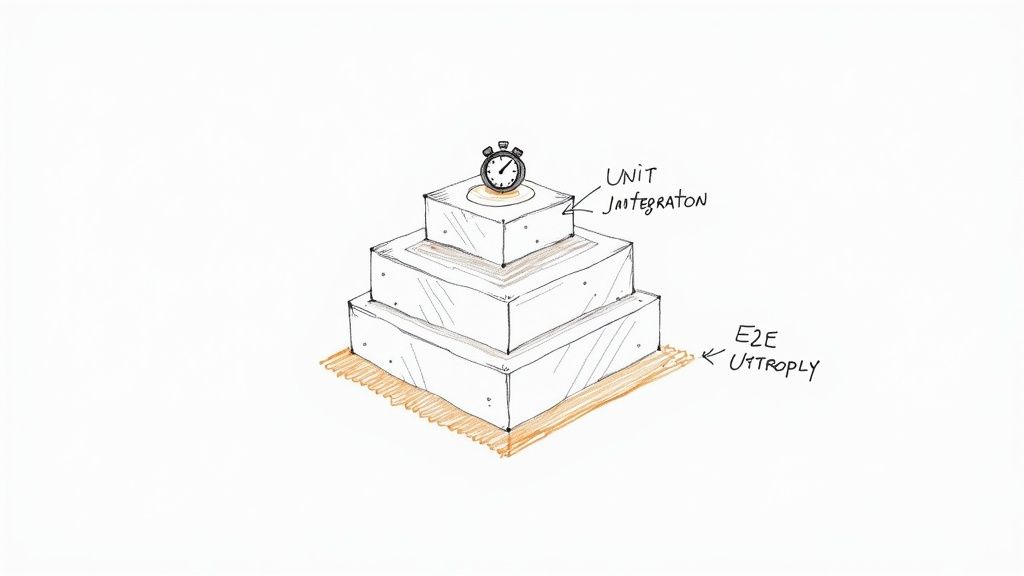
A comprehensive automated testing strategy is often visualized as the Testing Pyramid, which guides the allocation of testing efforts:
- Unit Tests: Form the large base of the pyramid. They are fast, isolated tests that verify individual functions or components work as expected.
- Integration Tests: The middle layer. These tests check that different components or services collaborate correctly. They are slower and more complex than unit tests.
- End-to-End (E2E) Tests: The small top of the pyramid. These simulate a full user journey through the application, from the UI to the database, ensuring the entire system functions cohesively.
This layered approach provides a rapid feedback loop at the unit level while ensuring high-level workflows are validated, optimizing both speed and confidence.
Why It's a Best Practice
Automated testing provides a safety net that allows teams to develop and refactor code with confidence. By catching regressions early, it dramatically reduces the cost and effort of fixing bugs. Tech giants like Google and Netflix rely on massive automated test suites to maintain stability across their complex, constantly evolving systems. This practice is fundamental to enabling Continuous Integration and Continuous Delivery (CI/CD), as it provides the automated verification needed to deploy code frequently and reliably.
How to Implement Automated Testing
Begin by integrating testing frameworks that suit your technology stack, such as Jest for JavaScript, JUnit for Java, or Pytest for Python.
- Follow the Pyramid: Prioritize writing many fast unit tests, a moderate number of integration tests, and very few slow E2E tests.
- Test Behavior, Not Implementation: Focus tests on what the code should do, not how it does it. This makes tests more resilient to refactoring.
- Keep Tests Independent: Each test should run in isolation and not depend on the state or outcome of other tests. Use the Arrange-Act-Assert pattern for clarity.
- Aim for Sensible Coverage: Strive for 70-80% code coverage as a practical goal. 100% coverage often yields diminishing returns and doesn't guarantee bug-free code.
By building a robust, multi-layered automated testing strategy, you create a more resilient and maintainable product while accelerating your development lifecycle.
8. Code Refactoring
Code refactoring is the disciplined process of restructuring existing computer code, altering its internal structure without changing its external behavior. It is a critical best practice for software development that focuses on improving nonfunctional attributes like readability, simplicity, and maintainability. Think of it as tidying up a workshop; the tools remain the same, but they are organized for greater efficiency and safety.
The core idea, famously cataloged by Martin Fowler in his seminal book "Refactoring," is to make a series of small, behavior-preserving transformations. Each change, like renaming a variable for clarity or extracting a complex block of logic into its own method, is minor on its own. Cumulatively, these changes prevent code from decaying over time, making it easier and less risky to add new features or fix bugs in the future.
This practice is the antidote to technical debt. Instead of letting complexity accumulate until a major rewrite is necessary, refactoring allows teams to continuously pay down that debt. It's an ongoing activity, not a one-time event, ensuring the codebase remains healthy, adaptable, and a pleasure to work with.
Why It's a Best Practice
Adopting a continuous refactoring mindset directly combats software entropy and reduces the total cost of ownership. It makes codebases more understandable for new developers, speeds up future development, and makes debugging significantly easier. The open-source Linux kernel, for instance, undergoes constant refactoring to maintain its quality and manage contributions from thousands of developers. This practice is essential for long-term project viability.
How to Implement Code Refactoring
Integrating refactoring into your daily workflow requires discipline and the right support systems, primarily a solid test suite.
- Refactor with a Safety Net: Never refactor code that isn't covered by automated tests. Tests are your guarantee that you haven't accidentally changed the code's behavior.
- Make Small, Incremental Changes: Avoid large, sweeping refactors. Make one small change, run the tests to confirm everything still works, and then commit. Version control makes it easy to revert if a change introduces a problem.
- Use IDE Tooling: Modern IDEs like IntelliJ IDEA and Visual Studio Code have powerful, automated refactoring tools. Use them to safely perform common tasks like renaming variables, extracting methods, and simplifying complex conditionals.
- Apply the Boy Scout Rule: A principle from Robert C. Martin, this rule states, "Always leave the code cleaner than you found it." If you see an opportunity for a small improvement while working on a feature, take it.
By treating refactoring as a routine part of development, not a separate, scheduled task, teams can maintain high-quality code and high velocity indefinitely.
9. Design Patterns
Design patterns are reusable, well-documented solutions to commonly occurring problems within a given context in software design. They are not finished designs that can be transformed directly into code but rather templates for how to solve a problem that can be used in many different situations. This approach is a crucial best practice for software development because it provides a shared vocabulary and proven solutions, leading to more maintainable and flexible systems.
The concept, famously cataloged by the "Gang of Four" (GoF) in their book Design Patterns: Elements of Reusable Object-Oriented Software, categorizes patterns into three main types:
- Creational: Patterns that deal with object creation mechanisms, trying to create objects in a manner suitable to the situation (e.g., Factory, Singleton).
- Structural: Patterns that ease the design by identifying a simple way to realize relationships between entities (e.g., Adapter, Decorator).
- Behavioral: Patterns that identify common communication patterns between objects and realize these patterns (e.g., Observer, Strategy).
By leveraging these established templates, developers can avoid reinventing the wheel and build upon the collective experience of the software engineering community. This leads to more robust, scalable, and elegant architectural decisions.
Why It's a Best Practice
Adopting design patterns significantly improves code quality and team communication. They provide a high-level language for developers to discuss solutions without getting lost in implementation details. This common understanding accelerates development and simplifies onboarding new team members. Frameworks like the Spring Framework for Java are built on a foundation of design patterns like Dependency Injection and Proxy, demonstrating their power in creating large-scale, enterprise-ready applications.
How to Implement Design Patterns
To effectively use design patterns, focus on understanding the problem a pattern solves rather than just memorizing its structure. Start by identifying recurring problems in your codebase and then find the appropriate pattern.
- Learn the Fundamentals: Start with the foundational Gang of Four (GoF) patterns to build a strong base.
- Focus on Intent: Understand the why behind a pattern, not just the how. This helps you apply it correctly.
- Don't Force It: The biggest mistake is applying a pattern where it isn't needed. Use them to solve real, existing problems, not for the sake of using them.
- Study Frameworks: Analyze how popular frameworks in your stack (e.g., React, Spring) use design patterns to solve common challenges.
By thoughtfully applying design patterns, teams can build sophisticated systems that are easier to understand, maintain, and extend over time, solidifying it as an essential best practice for software development.
10. Agile Development and Iterative Practices
Agile Development is an iterative approach that prioritizes flexibility, customer collaboration, and rapid delivery. Instead of a rigid, long-term plan, Agile methodologies break down large projects into small, manageable increments called sprints or iterations. This framework, outlined in the Agile Manifesto, allows teams to adapt to changing requirements and deliver value continuously, making it an essential best practice for software development in a fast-paced market.
The core of Agile lies in its iterative cycles and feedback loops. Methodologies like Scrum and Kanban provide structured processes for planning, executing, and reviewing work.
- Scrum uses fixed-length sprints (typically 1-4 weeks) with defined roles (Product Owner, Scrum Master, Development Team) and ceremonies (Daily Standup, Sprint Planning, Sprint Review, Sprint Retrospective).
- Kanban is a more fluid system focused on visualizing workflow, limiting work in progress (WIP), and maximizing flow.
These approaches foster close collaboration between developers and stakeholders, ensuring the final product aligns with user needs. The focus on delivering functional software in short cycles means teams can get feedback early and often, reducing the risk of building the wrong thing.
Why It's a Best Practice
Adopting Agile practices dramatically improves a team's ability to respond to change. It promotes transparency, accountability, and continuous improvement through regular retrospectives. Companies like Spotify and Amazon leverage Agile principles to innovate quickly and maintain a competitive edge. This iterative nature enables the frequent release of valuable features, a core component of which is understanding what constitutes a Minimum Viable Product (MVP) to deliver essential functionality to users faster.
How to Implement Agile
Successfully implementing Agile requires a cultural shift towards collaboration and empiricism. Start by choosing a framework that fits your team's context.
- Establish a Rhythm: Keep sprints short and consistent, typically one or two weeks, to establish a predictable delivery cadence.
- Hold Effective Retrospectives: Create a blameless environment where the team can honestly reflect on what went well and what can be improved.
- Empower the Product Owner: Ensure the Product Owner is engaged and has the authority to prioritize the backlog based on business value.
- Use Visual Tools: Leverage tools like Jira, Trello, or Azure DevOps to visualize workflows, track progress, and facilitate communication.
By embracing Agile values, not just its ceremonies, teams can build better products, respond faster to market demands, and create a more sustainable and collaborative work environment.
Top 10 Software Development Best Practices Comparison
| Approach | Implementation Complexity 🔄 | Resource Requirements & Speed ⚡ | Expected Outcomes 📊 | Ideal Use Cases 💡 | Key Advantages ⭐ |
|---|---|---|---|---|---|
| Test-Driven Development (TDD) | High — disciplined Red/Green/Refactor cycle; steep learning curve | Moderate dev time upfront; test frameworks + CI; slower initial velocity | High code quality and coverage; fewer regressions | Safety-critical, large teams, long-term maintenance | Early bug detection; safer refactoring; living documentation |
| Code Review and Peer Review | Medium — process + tooling; can become bottleneck if unmanaged | Low–Moderate: reviewer time, PR tools; async faster than pair reviews | Improved consistency, fewer production bugs, knowledge sharing | All teams (esp. 3+ devs), open source, critical merges | Catches issues early; mentors juniors; enforces standards |
| Continuous Integration / Continuous Deployment (CI/CD) | High — complex pipelines and deployment automation | High: CI/CD servers, infra-as-code, comprehensive tests; high setup cost | Faster, frequent releases; automated validation; reduced human error | Web apps, microservices, teams needing fast delivery | Rapid feedback loops; scalable, repeatable deployments |
| Documentation and Code Comments | Low–Medium — ongoing maintenance effort | Low–Moderate: writer time, docs tools; quick to set up but needs upkeep | Reduced onboarding time; preserved knowledge; easier debugging | Long-lived projects, APIs, multi-team codebases | Improves maintainability; reduces ramp-up and miscommunication |
| Version Control with Git | Medium — tooling and branching workflows to learn | Low: hosting service and developer training; highly efficient workflow | Full traceability, parallel work, safe rollbacks | Essential for all professional software development | Fundamental collaboration, history, and branching support |
| SOLID Principles | Medium — conceptual learning; requires design discipline | Low: design time and refactoring effort; no heavy infra | More maintainable, testable, loosely coupled code | OOP, enterprise and complex systems | Better architecture; easier testing and extension |
| Automated Testing (Unit/Integration/E2E) | High — extensive test suites across layers; maintenance overhead | Moderate–High: test infra, CI, frameworks; can slow pipeline if heavy | Fewer regressions, safe refactoring, faster developer confidence | All production systems, critical workflows, libraries | Automated regression detection; reliable change validation |
| Code Refactoring | Medium — requires understanding and safety nets (tests) | Low–Moderate: developer time and test coverage; incremental approach | Reduced technical debt; cleaner, more maintainable code | Ongoing maintenance, legacy cleanup, performance improvements | Improves readability and future productivity; lowers defects |
| Design Patterns | Medium–High — requires experience to apply appropriately | Low–Moderate: design time, documentation; minimal infra | Reusable, extensible solutions and clearer architecture | Medium–large projects needing consistent architecture | Proven templates; improved team communication and reuse |
| Agile Development & Iterative Practices | Medium — process change, ceremonies, stakeholder involvement | Low–Moderate: tooling and meeting cadence; fast iterations improve throughput | Faster delivery of value, rapid feedback, adaptive planning | Startups, product teams, environments with changing requirements | Iterative value delivery; better alignment with business priorities |
Integrating Excellence into Your Daily Workflow
We have journeyed through a comprehensive landscape of software development best practices, from the foundational principles of Test-Driven Development and SOLID to the operational excellence of a robust CI/CD pipeline. Each practice, whether it's diligent code review, strategic refactoring, or clear documentation, serves as a crucial building block in the architecture of high-quality, resilient, and maintainable software. Adopting these standards is not about checking boxes; it is about cultivating a deep-seated culture of craftsmanship, collaboration, and continuous improvement within your development team.
The transition from understanding these concepts to implementing them can seem daunting. The key is to recognize that this is not an all-or-nothing proposition. True mastery of any best practice for software development is an iterative process, much like the Agile methodologies we discussed. It begins with small, deliberate changes that gradually compound into significant, lasting improvements. Your journey might start with enforcing mandatory code reviews for every pull request or introducing a single, well-defined unit test for a critical function. The goal is to build momentum and demonstrate value, creating a virtuous cycle where success fuels further adoption.
From Theory to Tangible Results
The real power of these practices is unlocked when they are integrated seamlessly into your team's daily rhythm. When automated testing becomes an unquestioned part of every commit, developers gain the confidence to refactor and innovate without fear of regression. When CI/CD pipelines are optimized, the friction between writing code and delivering value to users disappears, replaced by a smooth, predictable flow.
Consider the practical implications:
- Reduced Risk: Practices like automated testing, version control, and security scanning directly mitigate the risk of deploying faulty or vulnerable code.
- Enhanced Velocity: A well-oiled CI/CD workflow, combined with clear documentation and design patterns, accelerates development by removing bottlenecks and reducing cognitive overhead.
- Improved Scalability: SOLID principles and consistent refactoring ensure that your codebase remains flexible and adaptable, ready to accommodate future growth and changing requirements.
- Higher Team Morale: Empowering developers with efficient tools and clear processes fosters a sense of ownership and satisfaction, reducing burnout and improving retention.
Ultimately, these practices are not just about writing better code; they are about building better products and stronger teams. They transform the development process from a series of disjointed tasks into a cohesive, streamlined system designed for sustained success.
Your Next Steps on the Path to Excellence
As you reflect on the ten pillars we've covered, the most important action you can take is to start. Identify the single biggest pain point in your current workflow. Is it merge conflicts and a backed-up CI queue? Is it inconsistent code quality? Is it a lack of clear documentation for new team members?
Pick one area and commit to improving it. For instance, if your merge process is chaotic, look for automation tools that can enforce the checks and balances discussed in the code review and CI/CD sections. If code quality is the issue, introduce a linter into your pipeline and formalize your peer review checklist. The most effective best practice for software development is the one you actually implement and stick with. By consistently applying these principles, you are not just following a guide; you are investing in the long-term health of your software and the professional growth of your team.
Ready to eliminate CI bottlenecks and streamline your development workflow? Mergify automates your pull request merges with a powerful rules engine and a merge queue, ensuring your code is always stable and your team stays productive. See how it can enforce the best practices you've just read about by visiting Mergify to start your free trial.





